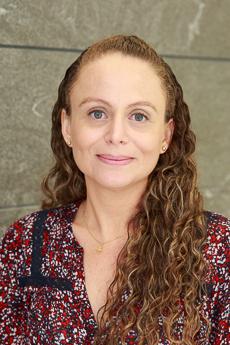Cheryl Clarkson

Cheryl Clarkson
Senior Research Scientist
Contact:
Cheryl Clarkson, DMD, PhD joined GW in 2017 as a research scientist at GWNIC. Her PhD training at University of Salamanca was centered on understanding the homeostatic plasticity in the brainstem after sensorial deprivation, using a variety of neuroanatomical, microscopic, genetic and physiological techniques. Her postdoctoral appointment at University of Pittsburgh was focused in changes at pre/postsynaptic neuronal and glial components after temporal deprivation; she was using mostly ultrastructural/molecular analyses at the electron microscopic level, including freeze substitution, postembedding immunogold labeling and serial section 3D reconstructions.
At the GWNIC she has been involved in experiments dedicated to demonstrating, using high technology FibSEM/3D reconstruction approaches, the development of a new procedure for generating miniature 3D versions of the brain called “organoids” from human stem cells, creating the first organoids capable of myelination, modeling the brain’s structure and function more closely than ever. Cheryl has been developing biological experiments for correlative light and electron microscopy (FibSEM) to localize and identify different types of cells with particular ultrastructure characteristics and also working as part of a team to design an innovative image analysis workflow for mining SEM+ postembedding images to quantify proteins expression at different areas of the brain.
Her work has been published in several peer-reviewed neuroscience journals.
- Fellowship for best academic results; University of Valle, Cali-Colombia (1997-2002)
- Fellowship; University of Salamanca, Neuroscience Graduate Program (2005-2006)
- Outstanding Summa Cum Laude by unanimity of master of advanced studies; University of Salamanca, Spain (2006)
- Fellowship from Banco de Santander and University of Salamanca, Best Latin American PhD students, Spain (2007-2009)
- Outstanding Summa Cum Laude by unanimity at PhD Neuroscience thesis; University of Salamanca, Spain (2009)
- Extraordinary Award, best graduated student, Medical School; University of Salamanca, Spain (2010)
- Diatome Award, First Place; Microscopy and Microanalysis Meeting; Baltimore, MD (August 2018)
Neuroanatomy Electron Microscopy
- Clarkson C, Smeal RM, Gibbons MG, White JA, Rubio ME, Wilcox KS. (2020). Ultrastructural and functional changes at the tripartite synapse during epileptogenesis in a model of temporal lobe epilepsy. Exp Neurol.:113196
- Claire-Marie Vacher, Jiaqi J. O’Reilly, Jacquelyn Salzbank, Helene Lacaille, Dana Bakalar, Sonia Sebaoui-Illoul, Philippe Liere, Cheryl Clarkson-Paredes, Toru Sasaki, Aaron Sathyanesan, Yuka Imamura Kawasawa, Anastas Popratiloff, Kazue Hashimoto-Torii, Vittorio Gallo, Michael Schumacher, Anna A. Penn. (2019). Placental neurostereoids shape cerebellar development and social behavior. bioRxiv. doi: https://doi.org/10.1101/730150
- Madhavan M, Nevin ZS, Shick HE, Garrison E, Clarkson-Paredes C, Karl M, Clayton BLL, Factor DC, Allan KC, Barbar L, Jain T, Douvaras P, Fossati V, Miller RH, Tesar PJ. (2018). Induction of myelinating oligodendrocytes in human cortical spheroids. Nat Methods. 15(9):700-706.
- Clarkson C, Antunes FM, Rubio ME. (2016). Conductive Hearing Loss Has Long- Lasting Structural and Molecular Effects on Presynaptic and Postsynaptic Structures of Auditory Nerve Synapses in the Cochlear Nucleus. The Journal of Neuroscience, 28 September 2016, 36(39):10214-10227; doi:10.1523/JNEUROSCI.0226-16.2016
- Rubio ME, Fukazawa Y, Kamasawa N, Clarkson C, Shigemoto R. (2014). Target- and input-dependent organization of AMPA and NMDA receptors in synaptic connection of the cochlear nucleus. J Comp Neurol. 522(18):4023-42
- Clarkson C, Herrero-Turrion MJ, Merchán MA. (2012). Cortical Auditory Deafferentation Induces Long-Term Plasticity in the Inferior Colliculus of Adult Rats: Microarray and qPCR Analysis. Front Neural Circuits: 6:86
- Clarkson C, Juíz JM, Merchán MA. (2010). Transient Down-Regulation of Sound- Induced c-Fos Protein Expression in the Inferior Colliculus after Ablation of the Auditory Cortex. Front Neuroanat Oct 20:4:141.
- Clarkson C, Juiz JM, Merchán MA. (2010). Long-Term Regulation in Calretinin Staining in the Rat Inferior Colliculus After Unilateral Auditory Cortical Ablation. J Comp Neurol. Oct 15;518(20):4261-76.
- Clarkson C, López DE, Merchán MA. (2009). Long-Term Functional Recovery in the Rat Auditory System After Unilateral Auditory Cortex Ablation. Acta Otolaryngol. 2009 Aug 13:1-7.
- Clarkson C, Escobar BM, Molina PA, Niño MM, Soto L, Puerta G. (2004). Estudio cefalométrico en niños con síndrome de Down del Instituto Tobías Emanuel. Revista Colombia Médica, Vol. 35, No. s1: 24-30
- Clarkson C, Escobar BM, Molina PA, Niño MM, Soto L, Puerta G. (2004). Cambios en el macizo cráneo encefálico: Niños con síndrome de Down. Revista de Estomatología de la Universidad del Valle, único número.
- DMD degree from the Faculty of Dentistry at the University of Valle (Cali, Colombia)
- MS (Neuroscience); University of Salamanca (Salamanca, Spain)
- PhD (Neuroscience); University of Salamanca (Salamanca, Spain)

